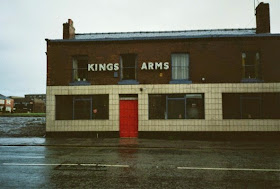Greengate Brewery, Middleton Junction, Middleton. (c) JW Lees [1].
Knox's Cottage is the brewery tap and visitor's centre at JW Lees' Greengate Brewery, Middleton Junction. It's named after Bobby Knox, the old caretaker who used to live in the cottage, and was turned into the on-site pub after he died in 1992. His granddaughter, Coronation Street's Suranne Jones, opened the refurbished pub in 1998. Whilst it's not open to the public most of the time, you can enjoy a few pints in Knox's Cottage as part of the brewery tour, on
open days, or at private functions. We popped in for pre-Christmas pint and a look around this famous old brewery.
Kicking off with a Brewers Dark, a low strength but tasty dark mild, Manchester Pale Ale (MPA) was next up. This ale has been well-promoted and equally well-received as a pale and hoppy beer to placate those of us who miss Boddington's cask bitter. Personally, I reckon Lees could do with adding at least as many hops again to give it the bitterness and aroma of old Boddies, and make MPA stand out from Robinson's Dizzy Blonde, Holt's IPA, and so on. The evening's barman, and JW Lees' head brewer, Paul Wood, then suggested we take a look around the brewery itself to work up a thirst.


The brewery is pleasingly old-fashioned with something historical around every corner and up every set of steep wooden stairs. The control panel is right out of the 1970s and the malted barley milling machine is almost a century old but in perfect working order. Speaking of the '70s, JW Lees beers had a reputation for inconsistency for many years, and I recall being served pints of dodgy Lees in the
Sportsmans and the
John Willie Lees in town in the early 1990s. Thankfully investment from the '90s onwards has seen the brewery expand and the beer range and quality improve hugely.

Once the barley has been mashed to release the sugars, the liquor is ran off to the copper for
hop addition and boiling, but the spent grain is sent out to local farms as cattle
feed. Apparently, once a batch of spent grain underwent an early
fermentation, resulting in a field full of drunken cows! Up more wooden steps - so old that footstep-grooves are worn into the steps - to the modern (stainless steel) coppers where hops are added to the wort. Hop pellets are used these days, but the room is adorned with old hops sacks stamped with familiar English hop varieties like Goldings and Challenger.

As the
brewing process continues to the fermentation vessels, we pass the laboratories where the Lees house yeast strain is tended to. These modern microbiology and QC labs have been squeezed into an old part of the building where the brewery ghost is said to roam the corridor. This end of the brewery also houses the Carlsberg fermentation vessels - I wasn't aware that JW Lees brewed Carlsberg lager under contract. This is a significant part of the company's income and allows the brewers to experiment making smaller volumes of new and seasonal beers.
This is FV9 (fermentation vessell # 9) and is where the yeast get to work converting the sugars from the malted barley into alcohol and carbon dioxide over a period of several days. We opened the doors to the fermentation vessels containing Lees Bitter (the only beer Paul, the head brewer, drinks) and Christmas Plum Pudding, a rich, fruity seasonal (a current favourite and what I spent Christmas day supping) for a gawp inside.

The aroma escaping was lovely but of course I had to stick my head for a proper sniff. The hit of CO2 nearly knocked me out, but once composure was regained, it was fascinating to see the brew bubbling away, the yeast hard at work. These microbes are more important to beer than many appreciate. The characteristic flavour of some brewery's ale - Robinson's, Holt's, Lees themselves - comes largely from the yeast used, as raw ingredients are essentially the same. Lees' yeast is many generations old, and small amounts of yeast from a spent brew are pitched into the next. A bacterial infection nearly wiped out the yeast once, but a small number of cells were rescued from the labs.


As we neared the end of the tour we were allowed into the cellar where the ales are casked and the smooth-flow and lagers are kegged. Lees don't bottle their own beers, using Robinson's or Thwaites facilities for this, but the lines where beers are pumped into their containers and then trundle off to distribution (or the on-site pub) reminded us of the pints that waited us back in the warmth.


Walking back through the brewery yard, we passed the shiny
new boiler system and the crooked old chimney, and it was back into the pub, where were informed we could pull our own pints. Like in the old
Hydes Brewery Tap, this is a treat for ale and pub fans who are usually on the other side of the bar. The Bitter, John Willie Lees strong ale, and several Plum Porters were sampled. The latter two were especially good, and the Plum Pudding was thankfully on offer during our Christmas Day meal the other day! It was great to talk beer and pubs with Paul, who was a great host, both on the tour and in the pub (and good to finally meet the equally knowledgable
Tandleman).



















































